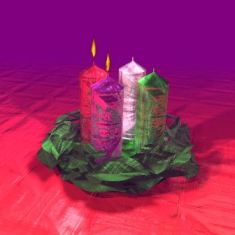 |
ALL TIMES, ALL SEASONS OBEY YOUR LAWS. ADVENT – WAITING FOR THE LORD. Advent (the name means ‘coming’) is the start of the church’s year and runs from the Sunday that falls on or closest to the 30th of November. It ends with the first evening prayer of Christmas. It is a season of reflection and preparation, of hope and anticipation as we wait for the coming of Christ - at Christmas, at the end of our lives and at the end of time. Although the ‘Gloria’ is omitted, Advent is less severe than Lent: flowers can still decorate the church (in moderation), music, although reduced, is allowed and the Gospel acclamation still includes the word ‘alleluia’. “...Advent is a season of devout and joyful expectation.” There are always four Sundays in Advent regardless of what day of the week Christmas Day falls on. The third is known as Gaudete Sunday and rose vestments may be worn – otherwise the colour is purple. The origins of Advent go back to the early centuries of the church. In Spain and Gaul (modern France) a period of fast was observed before the Feat of the Epiphany (6th January) the original feast of Christ’s birth and an important date for Baptisms. By the end of the fifth century we have the first written evidence of Advent as a time of preparation. By the middle of the sixth century the beginnings of an Advent liturgy can be seen in Rome. By the time of Pope Gregory the Great (590-604) the four Sundays of Advent are being celebrated. This was not universal and the length of Advent could vary from diocese to diocese – Milan still celebrates Advent with six Sundays. We owe the omission of the Gloria, something of its penitential character and the purple vestments to the influence from Gaul on the Roman liturgy in the twelfth century. The Gloria, “... is not omitted for the same reason as it is omitted in Lent, but in order that on the night of Christmas the angels’ song may ring out once again in all its newness.” |
||
.jpg) |
8th December - Solemnity of the Immaculate Conception of the Blessed Virgin Mary. Patron of the Diocese of Birmingham.
Through the centuries the Church has become ever more aware that Mary, ‘full of grace’ through God, was redeemed from the moment of her conception. That is what the dogma of the Immaculate Conception confesses, as Pope Pius IX proclaimed in 1854:”The most Blessed Virgin Mary was, from the first moment of her conception, by a singular grace and privilege of almighty God by virtue of the merits of Jesus Christ, Saviour of the human race, preserved immune from all stain of original sin.” The Immaculate Conception is not mentioned explicitly in Scripture although certain passages: the promised victory over the serpent (Genesis 3: 15), Gabriel's greeting (Luke 1: 28) and Elizabeth's tribute (Luke 1: 42), support it. The tradition of celebrating Mary's preservation from sin appears to have begun in the eastern Church in the seventh century where the focus was on St. Anne's conception of Mary and was universally observed in the Byzantine Empire by the ninth Century. The feast seems to have come to the west via Anglo-Saxon England, possibly brought over by pilgrims returning from the Holy Land. Edemer (c. 1055 - c. 1124), a disciple of St. Anselm, Archbishop of Canterbury, is credited with the first detailed treatise on the Immaculate Conception. Anselm's nephew, also called Anselm, before becoming Abbot of the Monastery of St. Edmund's Bury had been in Rome to which city the monks of the monastery of St. Sabas in Jerusalem had fled from the Saracen invaders. They had kept the feast of the Immaculate Conception for some centuries in Jerusalem and continued to do so in Rome where Anselm encountered them. Certain Medieval theologians: St. Bernard of Clairvaux, St. Thomas Aquinas and St. Bonaventure raised objections that the doctrine of the Immaculate Conception removed Mary from the company of those needing salvation and from the universality of the Lord Jesus Christ's redemptive work. They agreed that Mary had been sanctified in the womb but argued that she had to have been touched for at least one instant in order to be redeemed by the Lord Jesus Christ's grace. This objection was resolved by Duns Scotus with the insight that the Lord Jesus Christ can save in two ways: by rescuing the fallen, or by uniquely preserving someone from being touched by sin even for an instant. The Council of Trent (1545-1563) deliberately excluded Mary from its decree on original sin and taught in its decree on Justification that she was free from all sins throughout her entire life. The religious meaning of the dogma of Mary's sinlessness celebrates the victory of God's grace, His love and mercy poured out in abundance in the life, death and Resurrection of the Lord Jesus Christ, over the powers and principalities this world. In Mary's very being the grip of evil is broken. Through her "yes" to God, the Lord Jesus Christ is brought into the world through whom the effects of the ancient sin of Adam and Eve are overturned. Mary's Immaculate Conception brings the good news to fallen humanity that God's grace is greater than sin. The Immaculate Conception split the medieval monastic community. It was embraced enthusiastically by the Franciscans who adopted the feast in 1263 and the Carmelites but was opposed by the Dominicans and Cistercians. Outside of the last named orders the celebration of the Immaculate Conception was universal by the mid-fourteenth century. In 1477 Pope Sixtus IV approved it for the Diocese of Rome and the feast became obligatory for the Roman rite in 1708. How did the Parish of the Immaculate Conception, Bicester, get its name? Why was it dedicated to this specific title of Our Lady? In the Diocesan Archives in Birmingham there is a clue and it seems that we have to thank the party of exiled French nuns who were resident in Bicester in the early years of the twentieth century for the dedication. The item in question is a letter dated the 5th of June 1914 addressed presumably to the then Archbishop of Birmingham, Edward Ilsley from Sr. M. Therese Potter in which the correspondent offers words of encouragement in the case of an accusation made against the Novice Mistress and pleading for His Grace to take steps to stop the untrue reports which had been almost continual for over a year causing the Mother Superior to be humiliated before the community on the word of one novice. This intriguing but otherwise unremarkable letter is of interest because of two lines at its head, reproduced below. It is sent from, "The Priory of the Immaculate Conception, Bicester." The first known record of this title being used in connection with Bicester's Catholic community. At some stage in the years since their arrival and the foundation of St. Edith's Priory it appears that the name had changed - and would remain in Bicester following their departure in 1920, and still carry sufficient weight when the Parish of The Immaculate Conception, Bicester was created in the summer of 1943. The French nuns would, almost as a move to confirm the identity and dedication of the Catholic community in Bicester, leave behind them a large statue of the Immaculate Conception with Our Lady's words to St. Bernadette of Lourdes, "Je suis l'Immaculee Conception" forming the nimbus of the halo around Our Lady's head. After being an object of veneration for many years in both the old and the new churches the statue now has pride of place in St. Mary's School. Father, you prepared the Virgin Mary to be the worthy mother of your Son. You let her share beforehand in the salvation Christ would bring by his death and kept her sinless from the first moment of her conception. Help us by her prayers to live in your presence without sin. See also: https://www.newadvent.org/cathen/07674d.htm https://en.wikipedia.org/wiki/Immaculate_Conception https://www.papalencyclicals.net/Pius09/p9ineff.htm https://catholicsaints.info/feast-of-the-immaculate-conception/ https://www.christianiconography.info/goldenLegend/conception.htm https://www.bartleby.com/210/12/081.html https://saintscatholic.blogspot.com/2018/12/feast-of-immaculate-conception.html |
||
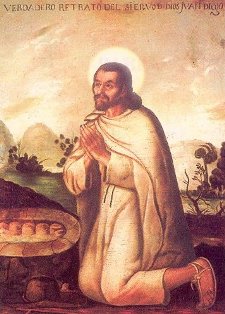 |
9th December - Optional memorial of St. Juan Diego Cuatitatoatzin. Born – 1474, Cuauhtitlán, Tenochtitlan, Aztec Empire, (located in modern Mexico) Died - 1548 (aged 73–74), Tepeyac, Mexico City, New Spain, (located in modern Mexico) Venerated in - Roman Catholic Church Beatified - May 6, 1990, Basilica of Our Lady of Guadalupe, Mexico City by Pope John Paul II Canonized - July 31, 2002, Basilica of Our Lady of Guadalupe, Mexico City by Pope John Paul II Major shrine - Basilica of Our Lady of Guadalupe Feast - December 9 Attributes - Tilma with the impressed image of the Virgin Mary, roses Patronage - Indigenous peoples of the Americas Little is known about the life of Juan Diego before his conversion, but tradition and archaeological and iconographical sources, along with the most important and oldest indigenous document on the event of Guadalupe, "El Nican Mopohua" (written in Náhuatl with Latin characters, 1556, by the Indigenous writer Antonio Valeriano), give some information on the life of the saint and the apparitions. Juan Diego was born in 1474 with the name "Cuauhtlatoatzin" ("the talking eagle") in Cuautlitlán, today part of Mexico City, Mexico. He was a gifted member of the Chichimeca people, one of the more culturally advanced groups living in the Anáhuac Valley. When he was 50 years old he was baptized by a Franciscan priest, Fr. Peter da Gand, one of the first Franciscan missionaries. On 9th December 1531, when Juan Diego was on his way to morning Mass, the Blessed Mother appeared to him on Tepeyac Hill, the outskirts of what is now Mexico City. She asked him to go to the bishop and to request in her name that a shrine be built at Tepeyac, where she promised to pour out her grace upon those who invoked her. The bishop, who did not believe Juan Diego, asked for a sign to prove that the apparition was true. On 12th December, Juan Diego returned to Tepeyac. Here, the Blessed Mother told him to climb the hill and to pick the flowers that he would find in bloom. He obeyed, and although it was winter time, he found roses flowering. He gathered the flowers and took them to Our Lady who carefully placed them in his mantle and told him to take them to the bishop as "proof". When he opened his mantle, the flowers fell on the ground and there remained impressed, in place of the flowers, an image of the Blessed Mother, the apparition at Tepeyac. With the Bishop's permission, Juan Diego lived the rest of his life as a hermit in a small hut near the chapel where the miraculous image was placed for veneration. Here he cared for the church and the first pilgrims who came to pray to the Mother of Jesus. Much deeper than the "exterior grace" of having been "chosen" as Our Lady's "messenger", Juan Diego received the grace of interior enlightenment and from that moment, he began a life dedicated to prayer and the practice of virtue and boundless love of God and neighbour. He died in 1548 and was buried in the first chapel dedicated to the Virgin of Guadalupe. He was beatified on 6th May 1990 by Pope John Paul II in the Basilica of Santa Maria di Guadalupe, Mexico City. O God, who by the means of Saint Juan Diego showed the love of the most holy Virgin Mary for your people, grant, through his intercession, that, by following the counsels our mother gave at Guadalupe, we may be ever constant in fulfilling your will. See also: https://en.wikipedia.org/wiki/Juan_Diego https://catholicsaints.info/saint-juan-diego/ https://saintscatholic.blogspot.com/2010/12/saint-juan-diego.html |
||
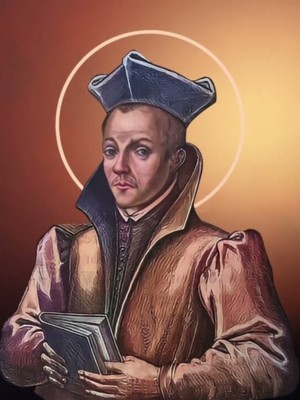 |
10th December - Optional memorial of St. Edmund Gennings, Priest and Martyr. Born – 1567, Lichfield, England Died - 1591 (aged 23–24), Gray's Inn, London, England Venerated in - Catholic Church Beatified - 15 December 1929 by Pope Pius XI Canonized - 25 October 1970, Vatican City, by Pope Paul VI Feast - 10 December Edmund Gennings was born in 1567 at Lichfield and had been brought up as a Protestant before coming under the influence of Richard Sherwood whose page he became in 1583. The following year he entered the English College at Reims and despite interruptions to his studies due to suspected tuberculosis he was ordained to the priesthood in 1590. He returned to England the same year landing at Whitby and made his way to Lichfield in an unsuccessful attempt to convert his brother. He returned to France but was again in England, this time in London in 1591 where he met fellow priest Polydore Plasden. Together they decided to celebrate Mass in the house of Swithun Wells in Gray’s Inn Lane. They were both arrested together with their congregation of ten. Both priests were tried together and were executed by being hung, drawn and quartered on the 10th of December 1591. Almighty ever-living God, by whose gift Saint Edmund Gennings fought for righteousness’s sake even until death, grant, we pray, through his intercession that we may bear every adversity for the sake of your love and hasten with all our strength towards you who alone are life. See also: https://en.wikipedia.org/wiki/Edmund_Gennings |
||
 |
11th December - Optional memorial of St. Damasus I, Pope. Born - c. 305 possibly Vimaranes (Guimarães) or Egitânia (nowadays Idanha-a-Velha, Portugal), Western Roman Empire Died - 11 December 384 (aged 78 – 79), Rome, Western Roman Empire Papacy began - 1 October 366 Papacy ended - 11 December 384 Predecessor - Liberius Successor - Siricius Feast day - 11 December (Catholicism), 13 November (Orthodoxy) Venerated in - Catholic Church, Eastern Orthodox Church Attributes - as a pope with patriarchal cross and model of a church Patronage - Archaeologists, against fever Damasus was born c. 304 in Rome but was of Spanish extraction. He became a deacon under Pope Liberius (310 – 24 September 366) and succeeded him in 366. Damasus’ pontificate is notable for a number of reasons, mainly for the energetic manner in which he combated the heresies of his time notably the Arians, Macedonians and Donatists. Most notably he promulgated the canon of scripture and commissioned Jerome to revise the Latin text of the Bible by producing a single vulgate version to replace the many different versions then in circulation. He also saw to the collection and housing of the papal archives and took a special interest in the Roman martyrs whose relics formed a unique collection that made Rome especially glorious. This was manifested by the famous collections of inscriptions and epigrams in their honour, many composed by Damasus himself. He was responsible for one of the earliest Latin translations of the Scriptures. In 383 he appointed his secretary St. Jerome, and commissioned him to revise the Latin Bible this bringing about the version known as the Vulgate. He died in 384 Grant, we pray, O Lord, that we may constantly exalt the merits of your blessed martyrs whom Pope St. Damasus so venerated and loved. See also: https://en.wikipedia.org/wiki/Pope_Damasus_I https://www.newadvent.org/cathen/04613a.htm https://catholicsaints.info/pope-saint-damasus-i/ https://www.bartleby.com/210/12/111.html https://saintscatholic.blogspot.com/2018/12/pope-saint-damasus-i.html |
||
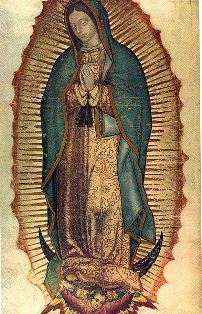 |
12th December - Optional memorial of Our Lady of Guadalupe. Approval - October 12, 1895 (canonical coronation granted by Pope Leo XIII) Shrine - Basilica of Our Lady of Guadalupe, Tepeyac Hill, Mexico City, Mexico Attributes - A pregnant woman, eyes downcast, hands clasped in prayer, clothed in a pink tunic robe covered by a cerulean mantle with a black sash, emblazoned with eight-point stars, eclipsing a blazing sun while standing atop a darkened crescent moon, a cherubic angel carrying her train The celebration of this feast goes back to the sixteenth century. A poor Indian named Cuauhtlatohuac was baptized and given the name Juan Diego. He was a 57-year-old widower and lived in a small village near Mexico City. On Saturday morning, 9th December 1531, he was on his way to a nearby barrio to attend Mass in honour of Our Lady. He was walking by a hill called Tepeyac when he heard beautiful music like the warbling of birds. A radiant cloud appeared and within it a young Native American maiden dressed like an Aztec princess. The lady spoke to him in his own language and sent him to the bishop of Mexico, a Franciscan named Juan de Zumarraga. The bishop was to build a chapel in the place where the lady appeared. Eventually the bishop told Juan Diego to have the lady give him a sign. About this same time Juan Diego’s uncle became seriously ill. This led poor Diego to try to avoid the lady. The lady found Diego, nevertheless, assured him that his uncle would recover and provided roses for Juan to carry to the bishop in his cape or tilma. When Juan Diego opened his tilma in the bishop’s presence, the roses fell to the ground and the bishop sank to his knees. On Juan Diego’s tilma appeared an image of Mary exactly as she had appeared at the hill of Tepeyac. The traditional depiction of Our Lady of Guadalupe is based in Juan Diego's account of the apparition. She appears neither as a native goddess nor a European Maddona, but as a combination of the two. Her dress is European while the decoration on it is indigenous. Her face is Mestizo. In this she bridges the gap between the New World and the Old; she is the universal mother. She appears very human, but her entire person radiates God's divinity. She appears pregnant and over her womb appears the Nahuatl symbol for the new centre of the universe, the Lord Jesus Christ, who, through Mary's obedience to the will of God, will become incarnate. She says the Juan Diego, "Do not be afraid, you have nothing to fear. Am I not here, your compassionate mother?" Lord God, father of mercies, you placed your people under the singular protection of the blessed Mother of your Only Son, grant that all who invoke Our Lady of Guadalupe may seek her with an ever more lively faith and bring about your Kingdom on earth of love, justice and peace. See also: https://www.newadvent.org/cathen/07043a.htm https://en.wikipedia.org/wiki/Our_Lady_of_Guadalupe https://catholicsaints.info/our-lady-of-guadalupe/ https://saintscatholic.blogspot.com/2010/12/our-lady-of-guadalupe.html |
||
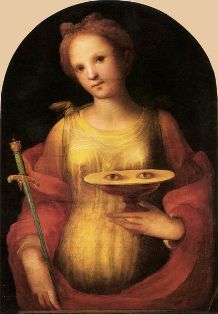 |
13th December - Memorial of St. Lucy, Virgin and Martyr. Born - c. 283, Syracuse, Roman Empire Died - 304 AD, Syracuse, Western Roman Empire Venerated in - Roman Catholic Church, Orthodox Church, Anglican Communion, Lutheranism Canonized - Pre-Congregation Major shrine - San Geremia, Venice Feast - 13 December, 16 September (duplicate feast in pre-1970 General Roman Calendar) Attributes - Cord; eyes; eyes on a dish; lamp; swords; woman hitched to a yoke of oxen; woman in the company of Saint Agatha, Saint Agnes of Rome, Barbara, Catherine of Alexandria, and Saint Thecla; woman kneeling before the tomb of Saint Agatha Patronage - The blind; martyrs; Perugia, Italy; Mtarfa, Malta; epidemics; salesmen; Syracuse, Italy; throat infections; writers; Sasmuan, Pampanga Philippines Little is known for certain about Lucy’s life. She died at Syracuse in 304 during the persecution of Diocletian and her name was included in the Canons of the Roman and Ambrosian rites and occurs in the oldest Roman sacramentaries. Her name was introduced into the Canon of the Mass by Pope Gregory I. According to legend she was a wealthy Sicilian who refused marriage offers, gave her goods to the poor and was accused by her suitor to the persecuting authority. The judge ordered that she should be violated in a brothel but she was made miraculously immobile. He then tried, unsuccessfully to have her burnt before she was finally put to death by the sword. In Christian iconography she is often depicted holding a dish containing her eyes which were reputed to have been torn out but which were miraculously restored. In Sweden, her feast on the shortest day of the year has become a festival of light where the youngest daughter, dressed in white, wakes the rest of the family with coffee, rolls and a special song. In England, prior to the Reformation, her day was kept as one on which no work except tillage or the land was allowed. Her body remained in Syracuse for some time but at length were moved to Italy and subsequently, under the authority of Emperor Otto I, to Metz where it is exposed for public veneration in a rich chapel in St. Vincent's Church. A portion of her relics were then taken to Constantinople and then brought to Venice. Lord God, may the intercession of the Virgin and Martyr, Saint Lucy give us new heart as we celebrate the day of her birth in heaven so that, in this present age we keep in mint the things that are eternal. See also: https://en.wikipedia.org/wiki/Saint_Lucy https://www.newadvent.org/cathen/09414a.htm https://catholicsaints.info/saint-lucy-of-syracuse/ https://www.christianiconography.info/goldenLegend/lucy.htm https://www.bartleby.com/210/12/131.html https://saintscatholic.blogspot.com/2018/12/saint-lucy-of-syracuse-virgin-martyr.html |